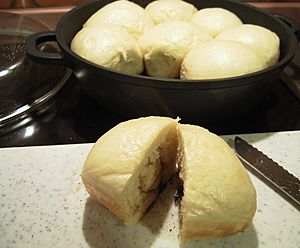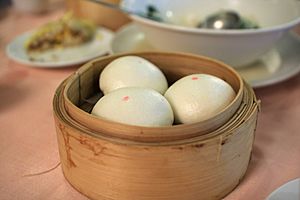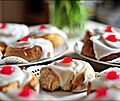List of buns facts for kids
Have you ever bitten into a soft, warm bun? Buns are small, often sweet, types of bread or bread rolls. They come in many shapes and sizes, but most are small enough to hold in your hand. They usually have a round top and a flat bottom. This article lists many different kinds of buns from all over the world!
Contents
- Awesome Buns from Around the World
- Buns Starting with A
- Buns Starting with B
- Buns Starting with C
- Buns Starting with D
- Buns Starting with F
- Buns Starting with H
- Buns Starting with I
- Buns Starting with J
- Buns Starting with K
- Buns Starting with L
- Buns Starting with M
- Buns Starting with N
- Buns Starting with P
- Buns Starting with Q
- Buns Starting with R
- Buns Starting with S
- Buns Starting with T
- Buns Starting with W
- Buns Starting with X
- Buns Starting with Z
- Images for kids
- See also
Awesome Buns from Around the World
Buns Starting with A
- Anpan – This is a Japanese bun usually filled with sweet red bean paste. Sometimes it has white beans, sesame, or chestnut inside.
Buns Starting with B
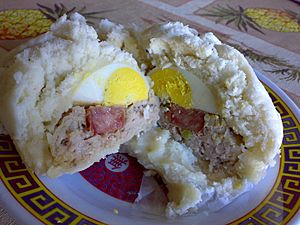
A bánh bao split in half, showing its yummy filling
- Bakpao – This is an Indonesian steamed bun. It's often filled with ground pork, but can also have sweet mung bean paste, peanuts, or vegetables.
- Bánh bao – From Vietnam, this bun means "Enveloping Cake." It's a round bun filled with pork or chicken meat, onions, eggs, mushrooms, and other vegetables.
- Baozi – A type of steamed bun from China. There are many different kinds of baozi with various fillings and ways of preparing them.
- Bath bun – A rich, round, sweet bun from England. It has a lump of sugar baked into the bottom and crushed sugar sprinkled on top.
- Beef bun – A popular pastry from Hong Kong. It's often found in Chinatown bakeries and has a tasty ground beef filling, sometimes with onion pieces.
- Belgian bun – A sweet bun with sultanas (a type of raisin). It's usually topped with sweet icing and half a glace cherry.
- Blaa – A special white bread bun from Waterford, Ireland. It's a soft, doughy roll.
- Boston bun – A large, spiced bun popular in Australia and New Zealand. It has a thick layer of coconut icing on top.
- Bread roll – A small, round, or oblong bun often served with meals, usually with butter.
- Bun kebab – A spicy Pakistani patty served in a hot dog bun with onions and chutney.
- Buñuelo – A fried dough ball popular in many places like Latin America and Greece. It usually has a filling or a topping.
- Butterkaka – Similar to cinnamon rolls, but many buns are baked together in a pan, like sticky buns.
Buns Starting with C
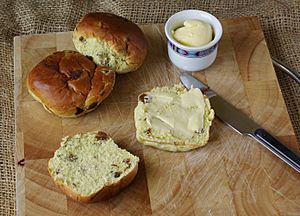
Small currant buns
- Cha siu bao – A Cantonese (Chinese) bun filled with delicious barbecue-flavored cha siu pork.
- Cheese bun – A small, baked roll flavored with cheese. It's a popular snack and breakfast food in countries like Brazil and Bolivia.
- Chelsea bun – A currant bun first made in the 1700s at the famous Chelsea Bun House in London, England.
- Cinnamon bun – A sweet roll popular in Northern Europe and North America. Its main ingredients are dough, cinnamon, sugar, and butter, giving it a strong, sweet flavor.
- Cocktail bun – A sweet bun from Hong Kong with a shredded coconut filling. It's one of Hong Kong's famous baked goods.
- Colston bun – A bun from Bristol, England, made with yeast dough, dried fruit, candied peel, and sweet spices.
- Cream bun – A bun that's different all over the world. Typically, it's a baked bread roll that's cooled, then split and filled with cream.
- Currant bun – A sweet bun that contains currants or raisins.
- Curry bread – A Japanese bun where curry is wrapped in dough, coated in bread crumbs, and then usually deep-fried or baked.
Buns Starting with D
- Da Bao – An extra large version of the Chinese steamed bun. Its name literally means "big bun."
- Dampfnudel – A white bread roll or sweet roll eaten as a meal or dessert in Germany and France.
Buns Starting with F
- Finger Bun – A hot dog-sized fruit bun with flavored icing, originally from Australia.
- Fruit bun – A sweet roll made with fruit, fruit peel, spices, and sometimes nuts. It's a tradition in Britain and former British colonies.
Buns Starting with H
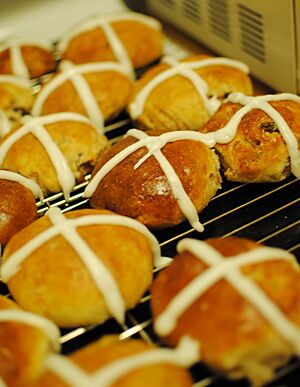
Hot cross buns with a cross on top
- Ham and egg bun – A Hong Kong bun or bread that contains a slice of egg and ham.
- Hamburger bun – A round bun made to hold a hamburger. It was invented in 1916 by Walter Anderson, who later helped start the White Castle restaurant chain.
- Hawaiian buns (also called Portuguese sweet bread) – A sweet bread roll brought to Hawaii by Portuguese immigrants.
- Heißwecke – A traditional type of currant bun from German-speaking regions, dating back to the Middle Ages.
- Honey bun – A sweet roll from America, similar to a cinnamon bun. It's very popular in the southeastern United States.
- Hoppang – A type of Korean steamed bun, similar to jjinppang.
- Hot cross bun – A sweet, spiced bun usually made with fruit and marked with a cross on top. Traditionally eaten on Good Friday in the UK, Australia, and other countries, but now popular all year.
- Hot dog bun – A long, soft bun shaped perfectly to hold a hot dog or frankfurter.
Buns Starting with I
- Iced bun – A bread roll made with a sweet recipe and covered with a shiny icing sugar glaze.
Buns Starting with J
- Jjinppang – A Korean steamed bun filled with sweet red bean paste.
Buns Starting with K
- Krachel – Moroccan buns, also known as Qrashel.
Buns Starting with L
- London bun – A square or rectangle bun from England, made from rich yeast dough flavored with currants or caraway seeds, and topped with white sugar icing.
- Longevity peach – A type of lotus seed bun that looks like a peach. It's white with a red tip and a crease on the side.
- Lotus seed bun – A Chinese sweet bun found in China. It's made by steaming a dough filled with lotus seed paste.
Buns Starting with M
- Manchet – A very high-quality yeast bread, often a small, flat, circular loaf that can be held in one hand.
- Mandarin roll – A steamed bun from China. It's a basic food in Chinese cuisine, similar to white bread in Western countries.
- Mantou – A steamed bread or bun from China. It's a main food in northern China, where wheat is grown more than rice.
- Melonpan – A sweet bun from Japan, also popular in Taiwan and Latin America. It's made from dough covered in a thin, crisp cookie dough layer.
- Momo – A type of dumpling from South Asia, popular in the Himalayan regions.
Buns Starting with N
- Nikuman – A bun made from flour dough and filled with cooked ground pork or other ingredients. It's a type of Chinese-style steamed bun.
- Nigerian buns – A type of bun from Nigeria.
Buns Starting with P
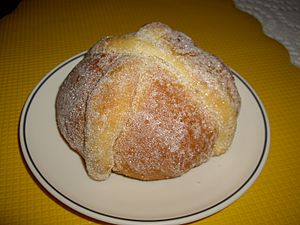
A piece of sugary pan de muerto
- Pampushka – A small savory or sweet yeast-raised bun or doughnut from Ukrainian cuisine.
- Pan de muerto – Spanish for "Bread of the Dead." This sweet roll is traditionally baked in Mexico for the Día de los Muertos celebration on November 1 and 2. It's often decorated to look like bones.
- Pão de queijo – A Brazilian cheese bread, which is a small, baked cheese roll. It's a popular snack and breakfast food in Brazil.
- Peanut butter bun – A Hong Kong sweet bun often found in Chinatown bakeries. It has layers of peanut butter filling, sometimes with a little sugar mixed in.
- Pets de sœurs – A French Canadian sweet bun, similar to a cinnamon bun.
- Pebete – An Argentine soft, oval bun made of wheat flour with a thin brown crust. It's a bit like a fatter hot dog roll.
- Penny bun – A small bread bun or loaf that used to cost one old penny in England. Its size could change depending on the cost of flour.
- Piggy bun – A Hong Kong pastry similar to a French baguette. In Hong Kong, it's often cut in half and served with butter and condensed milk.
- Pineapple bun – A sweet bun very popular in Hong Kong and Macau. Even though it's called "pineapple bun," the traditional version doesn't actually contain pineapple.
- Pork chop bun – A famous and popular snack in Macau. The "piggy bun" is crispy outside and soft inside, filled with a freshly fried pork chop.
Buns Starting with Q
- Qrashel – Moroccan buns or bread rolls made with sesame and anise seeds.
Buns Starting with R
- Rum roll – A historic specialty from Washington, D.C., similar to a cinnamon bun but with rum-flavored icing.
Buns Starting with S
- Saffron bun – A rich, spiced, yeast-leavened sweet bun flavored with saffron and cinnamon or nutmeg. It also contains currants.
- Sally Lunn bun – An enriched yeast bread from Bath, England.
- Sausage bun – A Hong Kong pastry, similar to pigs in a blanket. It's found in Hong Kong and many bakeries in Chinatowns.
- Semla – A traditional sweet roll made in various forms in Nordic and Baltic countries. It's often eaten around Lent. The oldest version was a plain bun eaten in warm milk.
- Shengjian mantou – A type of small, pan-fried baozi from Shanghai. It's usually filled with pork and a gelatin that melts into soup when cooked.
- Siopao – A term from the Hokkien language for bāozi (steamed buns). It's a popular food in Filipino and Thai cuisine.
- Spiced bun – A sweet bun with spices added. Famous examples include the hot cross bun and the Jamaican spiced bun.
- Sufganiyah – A deep-fried bun, filled with jam or custard, and topped with powdered sugar. It's typically eaten in Israel during Hanukkah.
- Sticky bun – A sweet roll for dessert or breakfast. It usually has rolled pieces of dough, sometimes with brown sugar or cinnamon, baked together in a pan.
Buns Starting with T
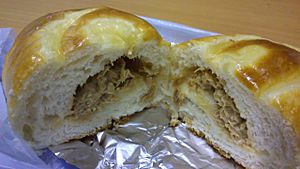
A tuna bun filled with canned tuna
- Teacake – A sweet bun with fruit, usually served toasted and buttered.
- Tingmo – A steamed bread in Tibetan cuisine. It's sometimes called a steamed bun and doesn't have any filling.
- Tuna bun – A Hong Kong-style fish bun filled with tuna paste. It's commonly found in Hong Kong.
Buns Starting with W
- Wang Mandu – A savory steamed bun filled with vegetables and meat. Its name literally means "king dumpling" or "big dumpling."
Buns Starting with X
- Xiaolongbao – A steamed bun from the Jiangnan region of China. Fillings vary but usually include meat and a gelatin that turns into soup when steamed.
Buns Starting with Z
- Zeeuwse bolus – A spiral-shaped bun covered in dark brown sugar, lemon zest, and cinnamon.
Images for kids
-
Cha siu bao, filled with char siu pork
-
Norwegian skillingsbolle, a type of cinnamon bun
-
A cross-section view of a cocktail bun, showing the coconut filling
-
Mantou, a type of steamed bun
-
A sticky bun loaf
See also

All content from Kiddle encyclopedia articles (including the article images and facts) can be freely used under Attribution-ShareAlike license, unless stated otherwise. Cite this article:
List of buns Facts for Kids. Kiddle Encyclopedia.


